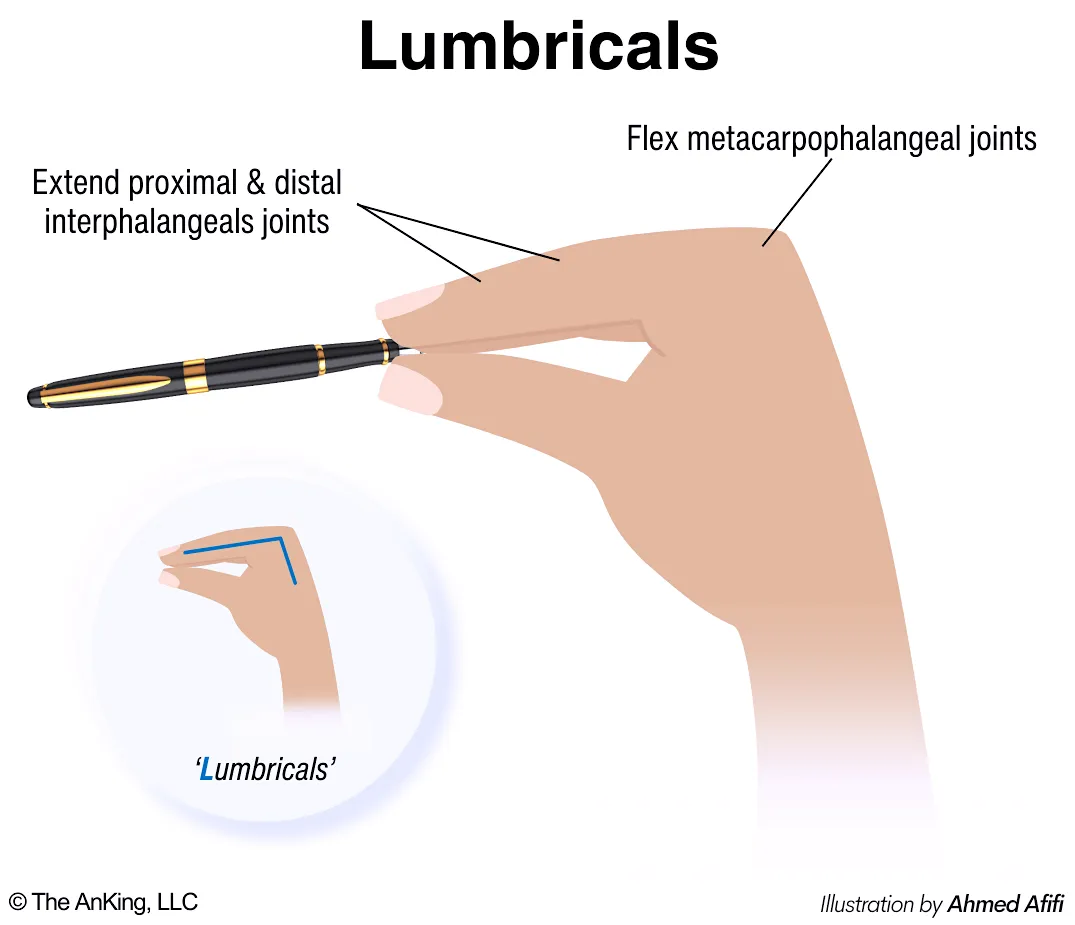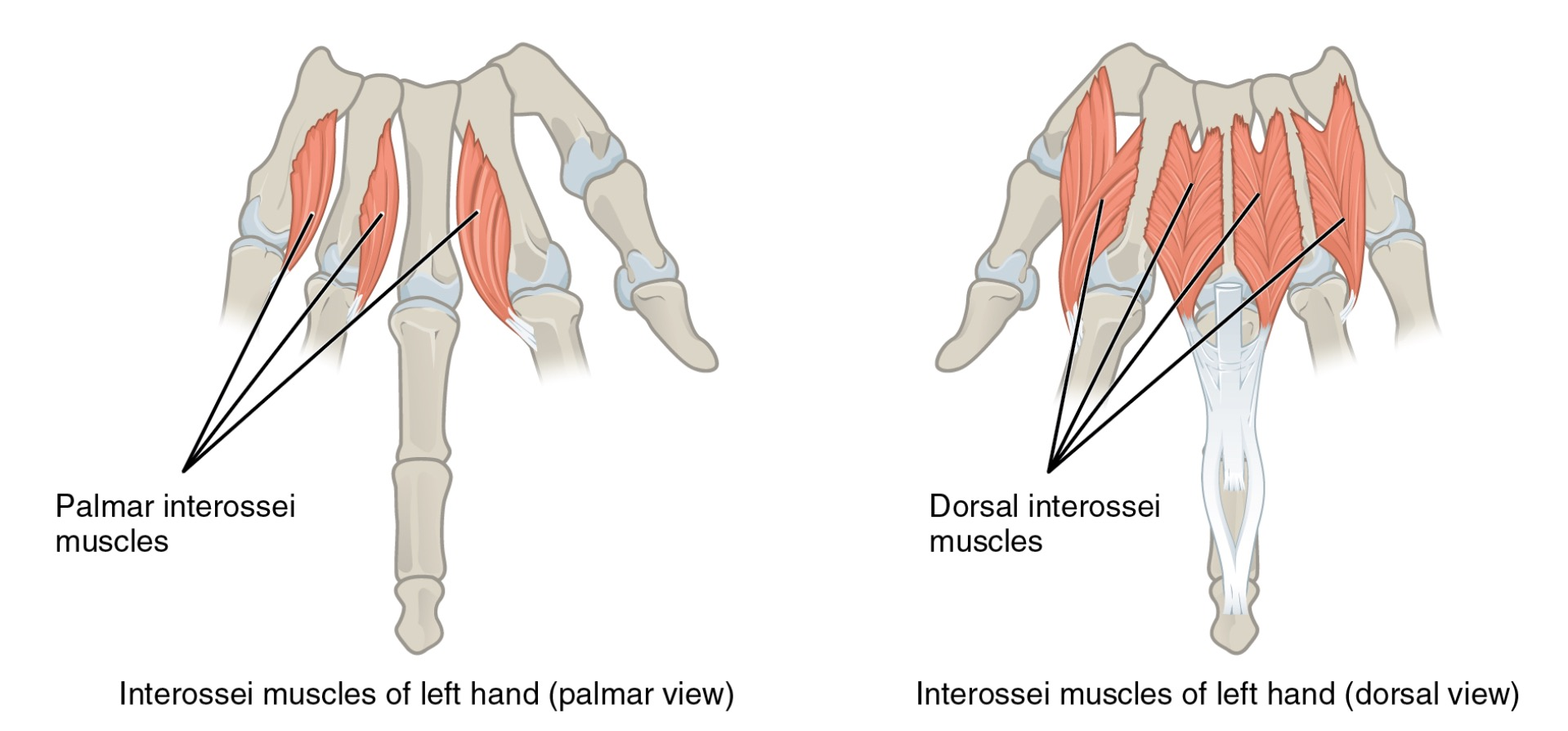Innervation Summary
- Median Nerve: Innervates most of the thenar muscles and the lateral two lumbricals.
- Mnemonic: “LOAF” or “OAF + Lateral 2 Lumbricals”
- Lumbricals 1 & 2
- Opponens pollicis
- Abductor pollicis brevis
- Flexor pollicis brevis (superficial head)
- Mnemonic: “LOAF” or “OAF + Lateral 2 Lumbricals”
- Ulnar Nerve: Innervates all other intrinsic hand muscles (“everything else”).
- Hypothenar muscles, all interossei, medial two lumbricals, and adductor pollicis.
Muscle Groups & Functions
Thenar Muscles (Median N.)
- Forms the thenar eminence (thumb pad). Responsible for thumb opposition.
- Muscles (OAF):
- Opponens pollicis: Opposes the thumb by rotating it medially.
- Abductor pollicis brevis: Abducts the thumb.
- Flexor pollicis brevis: Flexes the thumb’s MCP joint.
Hypothenar Muscles (Ulnar N.)
- Forms the hypothenar eminence (pinky side). Controls the 5th digit.
- Muscles (OAF):
- Opponens digiti minimi: Opposes the 5th digit.
- Abductor digiti minimi: Abducts the 5th digit.
- Flexor digiti minimi: Flexes the 5th digit’s MCP joint.
Lumbricals
- Action: Flex MCP joints and Extend IP (interphalangeal) joints.
- Innervation:
- 1st & 2nd (index, middle fingers): Median N.
- 3rd & 4th (ring, little fingers): Ulnar N.

Interossei (Ulnar N.)
- Dorsal Interossei (DAB): ABduct the fingers. There are 4.
- Palmar Interossei (PAD): ADduct the fingers. There are 3.
- Both groups assist lumbricals in flexing MCPs and extending IPs.

Other Intrinsic Muscles
- Adductor Pollicis (Ulnar N.): The most powerful adductor of the thumb.
- Palmaris Brevis (Ulnar N.): Wrinkles the skin of the hypothenar eminence, aiding grip.
Clinical Correlations & Buzzwords
-
Median Nerve Injury:
- “Ape Hand” Deformity: Wasting of the thenar eminence, leading to loss of opposition. The thumb falls back in line with the other fingers.
- “Hand of Benediction” / “Pope’s Blessing”: Seen when a patient with a proximal median nerve lesion tries to make a fist. They are unable to flex the 1st, 2nd, and 3rd digits, while the 4th and 5th digits flex (due to intact ulnar nerve).
- Anterior Interosseous Nerve (AIN) Syndrome: A pure motor neuropathy; patient cannot make the “OK” sign (loss of flexion at thumb IP and index DIP).
-
Ulnar Nerve Injury:
- “Ulnar Claw” / “Claw Hand”: Seen at rest in patients with a distal ulnar nerve lesion. Paralysis of the medial two lumbricals causes hyperextension of the 4th and 5th MCPs and flexion of the IPs.
- “Ulnar Paradox”: A proximal ulnar nerve lesion (e.g., at the elbow) results in a less prominent claw deformity than a distal lesion. This is because the ulnar-innervated part of the flexor digitorum profundus is also paralyzed, reducing flexion of the IP joints.
- Wasting of interosseous muscles: Leads to visible gutters between extensor tendons on the dorsum of the hand.
- Froment’s Sign: Patient is asked to hold paper between thumb and index finger. Weakness of the ulnar-innervated adductor pollicis causes the patient to flex their thumb IP joint (using the median-innervated FPL) to compensate.